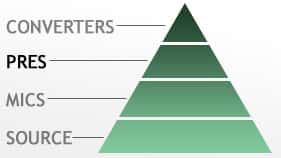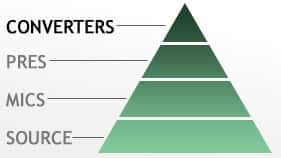
Signal Chain Hierarchy – Part 3: Preamps for Drums
The past two weeks, we’ve talked about my idea of the recording signal chain hierarchy – what makes the most difference in your sound. We started off this series talking about the source being primary in importance. Last week, we talked about microphones and their ability to shape the sound. Now, we get into the beautiful lights, tubes, and circuits that we who lust over tone refer to simply as “gear.” Specifically, we’re talking about microphone preamps for drums.
Different pres sound different. Tubes sound different from solid state, class A different from class A/B, iron transformers different than nickel, etc. However, for all the differences between pre sounds, for all the advertising in trade publications that lead us to believe that next purchase of ________ will be what takes our sound to the next level, I believe the pre makes little difference overall in the hierarchy of the signal chain. The pre acts more like a colored lens through which we see a picture rather than as a radical tone shaper. Some pres accent more of the transient of a signal, others warm and fatten the tone, but they won’t CHANGE the overall sonic characteristics of the sound. A bad snare drum or guitar tone through a really expensive hand-wired pre will just sound like a warmer, expensive, hand-wired version of a bad snare or guitar tone. However, if you start with a good source and microphone you like, the choice of preamps for drums becomes like your color palette to further enhance what you hear.
Let’s listen to some examples. I think you will find the examples less drastic than those from last week’s microphone tests. Still, there is a perceived difference in the color of the sound (light or dark) and the richness of the transients of the performance recorded. Again, the recording is done like last week – a single mic (Shure SM7b) around the backside of the kit pointing downward toward the kick and the snare. I’ll admit the positioning of the mic is a little non-standard. I put the mic behind the kit because I find that when testing preamps for drums, it’s a good way to quickly capture the transients from both the kick and snare at the point of impact. Further close miking tests reinforce those characteristics.
John Hardy Jensen Twin Servo 990
see the pre here
With it’s high quality Jensen transformers and dual 990 op-amps per channel, this is an incredibly high quality preamp. The transients are well represented without much coloring of the signal. An elegant and clean solid state pre. In the example, the high end lets the snare speak while not making the hi hats sound trashy.
Vintech x81
see the pre here
Designed after the famed Neve 1073 preamp and the EQ section of the Neve 1081 strip (which was not used in the recording), this pre retains the same sonic characteristics as its British big brother. Dark and punchy, with a little bit of grit describe this pre. I love it on drums. The transient really smacks, and the pre colors the tone making things darker and fatter. A colored solid state pre. In the example, the kit sounds punchy and a bit meaner.
Sebatron vmp-4000e
see the pre here
An Australian boutique valve preamplifier (valves being the British term for tubes) with nice bass and mids. Darker by nature with tons of gain options. I selected one of the more dark modes for the pre’s operation to make a more obvious comparison. I love how it brings out the mids while leaving things dark and all without being terribly bass-heavy. A lovely tube pre. In the example, the snare really jumps out in the mid range.
PreSonus BlueTube
see the pre here
A discontinued model from makers of intermediately priced pro-audio gear, PreSonus. A simple tube pre, I included this pre in the examples because I wanted to show that though I feel the more expensive pres sound better, even the cheaper pres (if fairly well designed) will not destroy a well-recorded source. In the example, I feel like the transients (especially the snare) aren’t as well represented as in the other example and the hi hats are brought out a little in a trashy way. Still, it doesn’t sound bad at all. Who says you need the expensive stuff for a good recording?
Hopefully you can hear how subtle the differences are between the preamps for drums compared to last week’s testing of microphones. The lesson? Start with a great source, follow with a mic that “hears” the sound the way you desire, THEN worry about what pre to select as a coloring agent. Next week we finish this series by talking about our A to D converters.


